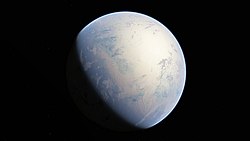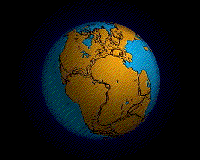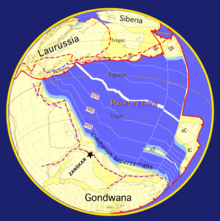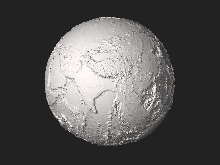Geological history of Earth

The geological history of the Earth follows the major geological events in Earth's past based on the
Initially, Earth was molten due to extreme volcanism and frequent collisions with other bodies. Eventually, the outer layer of the planet cooled to form a solid crust when water began accumulating in the atmosphere. The Moon formed soon afterwards, possibly as a result of the impact of a planetoid with the Earth. Outgassing and volcanic activity produced the primordial atmosphere. Condensing water vapor, augmented by ice delivered from comets, produced the oceans. However, in 2020, researchers reported that sufficient water to fill the oceans may have always been on the Earth since the beginning of the planet's formation.[1][2][3]
As the surface continually reshaped itself over hundreds of millions of years, continents formed and broke apart. They migrated across the surface, occasionally combining to form a supercontinent. Roughly 750 million years ago, the earliest-known supercontinent Rodinia, began to break apart. The continents later recombined to form Pannotia, 600 to 540 million years ago, then finally Pangaea, which broke apart 200 million years ago.
The present pattern of ice ages began about 40 million years ago, then intensified at the end of the Pliocene. The polar regions have since undergone repeated cycles of glaciation and thawing, repeating every 40,000–100,000 years. The Last Glacial Period of the current ice age ended about 10,000 years ago.
Precambrian
The Precambrian includes approximately 90% of geologic time. It extends from 4.6 billion years ago to the beginning of the Cambrian Period (about 539
Major volcanic events altering the Earth's environment and causing extinctions may have occurred 10 times in the past 3 billion years.[6]
Hadean Eon
During Hadean time (4.6–4
The Hadean Eon is not formally recognized, but it essentially marks the era before we have adequate record of significant solid rocks. The oldest dated zircons date from about 4,400 million years ago.[8][9][10]
During the Hadean the Late Heavy Bombardment occurred (approximately 4,100 to 3,800 million years ago) during which a large number of impact craters are believed to have formed on the Moon, and by inference on Earth, Mercury, Venus and Mars as well. However, some scientists argue against this hypothetical Late Heavy Bombardment, pointing out that the conclusion has been drawn from data which are not fully representative (only a few crater hotspots on the Moon have been analyzed).[15][16]
Archean Eon
The Earth of the early Archean (4,031 to 2,500 million years ago) may have had a different tectonic style. During this time, the Earth's
In contrast to the
The Earth's magnetic field was established 3.5 billion years ago. The solar wind flux was about 100 times the value of the modern Sun, so the presence of the magnetic field helped prevent the planet's atmosphere from being stripped away, which is what probably happened to the atmosphere of Mars. However, the field strength was lower than at present and the magnetosphere was about half the modern radius.[20]
Proterozoic Eon
The geologic record of the Proterozoic (2,500 to 538.8 million years ago
The first-known glaciations occurred during the Proterozoic, one that began shortly after the beginning of the eon, while there were at least four during the Neoproterozoic, climaxing with the Snowball Earth of the Varangian glaciation.[26]

Phanerozoic
The Phanerozoic Eon is the current eon in the geologic timescale. It covers roughly 539 million years. During this period continents drifted apart, but eventually collected into a single landmass known as
The Phanerozoic is divided into three eras – the Paleozoic, the Mesozoic and the Cenozoic.
Most of the evolution of multicellular life occurred during this time period.
Paleozoic Era
The Paleozoic era spanned roughly 539 to 251 million years ago (Ma)
Cambrian Period
The Cambrian is a major division of the
Ordovician period
The Ordovician period started at a major extinction event called the Cambrian–Ordovician extinction event some time about 485.4 ± 1.9 Ma.[9] During the Ordovician the southern continents were collected into a single continent called Gondwana. Gondwana started the period in the equatorial latitudes and, as the period progressed, drifted toward the South Pole. Early in the Ordovician the continents Laurentia, Siberia and Baltica were still independent continents (since the break-up of the supercontinent Pannotia earlier), but Baltica began to move toward Laurentia later in the period, causing the Iapetus Ocean to shrink between them. Also, Avalonia broke free from Gondwana and began to head north toward Laurentia. The Rheic Ocean was formed as a result of this. By the end of the period, Gondwana had neared or approached the pole and was largely glaciated.[citation needed]
The Ordovician came to a close in a series of extinction events that, taken together, comprise the second-largest of the five major extinction events in Earth's history in terms of percentage of genera that became extinct. The only larger one was the Permian-Triassic extinction event. The extinctions occurred approximately 447 to 444 million years ago [9] and mark the boundary between the Ordovician and the following Silurian Period.
The most-commonly accepted theory is that these events were triggered by the onset of an ice age, in the Hirnantian faunal stage that ended the long, stable greenhouse conditions typical of the Ordovician. The ice age was probably not as long-lasting as once thought; study of oxygen isotopes in fossil brachiopods shows that it was probably no longer than 0.5 to 1.5 million years.[29] The event was preceded by a fall in atmospheric carbon dioxide (from 7000ppm to 4400ppm) which selectively affected the shallow seas where most organisms lived. As the southern supercontinent Gondwana drifted over the South Pole, ice caps formed on it. Evidence of these ice caps has been detected in Upper Ordovician rock strata of North Africa and then-adjacent northeastern South America, which were south-polar locations at the time.[citation needed]
Silurian Period
The Silurian is a major division of the
Devonian Period
The Devonian spanned roughly from 419 to 359 Ma.
Carboniferous Period
The Carboniferous extends from about 358.9 ± 0.4 to about 298.9 ± 0.15 Ma.[9]
A global drop in sea level at the end of the Devonian reversed early in the
The Carboniferous was a time of active mountain building, as the supercontinent Pangea came together. The southern continents remained tied together in the supercontinent Gondwana, which collided with North America-Europe (

Permian Period
The Permian extends from about 298.9 ± 0.15 to 252.17 ± 0.06 Ma.[9]
During the Permian all the Earth's major land masses, except portions of East Asia, were collected into a single supercontinent known as Pangaea. Pangaea straddled the equator and extended toward the poles, with a corresponding effect on ocean currents in the single great ocean (Panthalassa, the universal sea), and the Paleo-Tethys Ocean, a large ocean that was between Asia and Gondwana. The Cimmeria continent rifted away from Gondwana and drifted north to Laurasia, causing the Paleo-Tethys to shrink. A new ocean was growing on its southern end, the Tethys Ocean, an ocean that would dominate much of the Mesozoic Era. Large continental landmasses create climates with extreme variations of heat and cold ("continental climate") and monsoon conditions with highly seasonal rainfall patterns. Deserts seem to have been widespread on Pangaea.
Mesozoic Era


The Mesozoic extended roughly from 252 to 66 million years ago.[9]
After the vigorous convergent plate mountain-building of the late
Triassic Period
The Triassic Period extends from about 252.17 ± 0.06 to 201.3 ± 0.2 Ma.[9] During the Triassic, almost all the Earth's land mass was concentrated into a single supercontinent centered more or less on the equator, called Pangaea ("all the land"). This took the form of a giant "Pac-Man" with an east-facing "mouth" constituting the Tethys sea, a vast gulf that opened farther westward in the mid-Triassic, at the expense of the shrinking Paleo-Tethys Ocean, an ocean that existed during the Paleozoic.
The remainder was the world-ocean known as Panthalassa ("all the sea"). All the deep-ocean sediments laid down during the Triassic have disappeared through subduction of oceanic plates; thus, very little is known of the Triassic open ocean. The supercontinent Pangaea was rifting during the Triassic—especially late in the period—but had not yet separated. The first nonmarine sediments in the rift that marks the initial break-up of Pangea—which separated New Jersey from Morocco—are of Late Triassic age; in the U.S., these thick sediments comprise the Newark Supergroup.[32] Because of the limited shoreline of one super-continental mass, Triassic marine deposits are globally relatively rare; despite their prominence in Western Europe, where the Triassic was first studied. In North America, for example, marine deposits are limited to a few exposures in the west. Thus Triassic stratigraphy is mostly based on organisms living in lagoons and hypersaline environments, such as Estheria crustaceans and terrestrial vertebrates.[33]
Jurassic Period
The Jurassic Period extends from about 201.3 ± 0.2 to 145.0 Ma.[9] During the early
Cretaceous Period

The Cretaceous Period extends from circa 145 million years ago to 66 million years ago.[9]
During the
To the north of Africa the
Cenozoic Era
The Cenozoic Era covers the 66 million years since the Cretaceous–Paleogene extinction event up to and including the present day. By the end of the Mesozoic era, the continents had rifted into nearly their present form. Laurasia became North America and Eurasia, while Gondwana split into South America, Africa, Australia, Antarctica and the Indian subcontinent, which collided with the Asian plate. This impact gave rise to the Himalayas. The Tethys Sea, which had separated the northern continents from Africa and India, began to close up, forming the Mediterranean Sea.
Paleogene Period
The Paleogene (alternatively Palaeogene)
Paleocene Epoch
The Paleocene, lasted from 66 million years ago to 56 million years ago.[9]
In many ways, the Paleocene continued processes that had begun during the late Cretaceous Period. During the Paleocene, the continents continued to drift toward their present positions. Supercontinent Laurasia had not yet separated into three continents. Europe and Greenland were still connected. North America and Asia were still intermittently joined by a land bridge, while Greenland and North America were beginning to separate.[41] The Laramide orogeny of the late Cretaceous continued to uplift the Rocky Mountains in the American west, which ended in the succeeding epoch. South and North America remained separated by equatorial seas (they joined during the Neogene); the components of the former southern supercontinent Gondwana continued to split apart, with Africa, South America, Antarctica and Australia pulling away from each other. Africa was heading north toward Europe, slowly closing the Tethys Ocean, and India began its migration to Asia that would lead to a tectonic collision and the formation of the Himalayas.
Eocene Epoch
During the
The northern
Oligocene Epoch
The Oligocene Epoch extends from about 34 million years ago to 23 million years ago.[9] During the Oligocene the continents continued to drift toward their present positions.
Neogene Period
The Neogene Period is a unit of
Miocene Epoch
The Miocene extends from about 23.03 to 5.333 Ma.[9]
During the
Pliocene Epoch
The Pliocene extends from 5.333 million years ago to 2.588 million years ago.[9] During the Pliocene continents continued to drift toward their present positions, moving from positions possibly as far as 250 kilometres (155 mi) from their present locations to positions only 70 km from their current locations.
South America became linked to North America through the
Quaternary Period
Pleistocene Epoch
The Pleistocene extends from 2.588 million years ago to 11,700 years before present.
Holocene Epoch

The Holocene Epoch began approximately 11,700 calendar years before present[9] and continues to the present. During the Holocene, continental motions have been less than a kilometer.
The
See also
- Astronomical chronology
- Chronological dating, archaeological chronology
- Absolute dating
- Relative dating
- Phase (archaeology)
- Archaeological association
- Geochronology
- General
- Consilience, evidence from independent, unrelated sources can "converge" on strong conclusions
References
- ^ S2CID 221342529. Retrieved 28 August 2020.
- ^ EurekAlert!. Retrieved 28 August 2020.
- ^ EurekAlert!. Retrieved 28 August 2020.
- . Retrieved 23 September 2022.
- ISSN 0705-3797.
- ^ Witze, Alexandra. "Earth's Lost History of Planet-Altering Eruptions Revealed". Scientific American. Retrieved 2017-03-14.
- ISBN 978-0-8047-1569-0.
- ISBN 9780521786737.
- ^ a b c d e f g h i j k l m n o p q r s t u v "International Chronostratigraphic Chart v.2015/01" (PDF). International Commission on Stratigraphy. January 2015.
- S2CID 4319774.
- Bibcode:2001AGUFM.U51A..02C.
- S2CID 4413525.
- S2CID 4387525.
- .
- S2CID 119258897.
- S2CID 84843306.
- ^ "Earth-Moon Dynamics". Lunar and Planetary Institute. Retrieved September 2, 2022.
- .
- ^ Stanley 1999, pp. 302–303
- ^ Staff (March 4, 2010). "Oldest measurement of Earth's magnetic field reveals battle between Sun and Earth for our atmosphere". Physorg.news. Retrieved 2010-03-27.
- ^ "Stratigraphic Chart 2022" (PDF). International Stratigraphic Commission. February 2022. Retrieved 25 April 2022.
- ^ Stanley 1999, p. 315
- ^ Stanley 1999, pp. 315–318, 329–332
- ^ International Stratigraphic Chart 2008, International Commission on Stratigraphy
- doi:10.1511/2004.4.324. Archived from the originalon 2007-07-13. Retrieved 2007-03-05.
- ^ Stanley 1999, pp. 320–321, 325
- ^ "Stratigraphic Chart 2022" (PDF). International Stratigraphic Commission. February 2022. Retrieved 25 April 2022.
- ^ "Stratigraphic Chart 2022" (PDF). International Stratigraphic Commission. February 2022. Retrieved 25 April 2022.
- ^ Stanley 1999, p. 358
- ^ Stanley 1999, p. 414
- ^ Stanley 1999, pp. 414–416
- ^ Olsen, Paul E. (1997). "Great Triassic Assemblages Pt 1 - The Chinle and Newark". Dinosaurs and the History of Life. Lamont–Doherty Earth Observatory of Columbia University.
- .
- ^ "Pangea Begins to Rift Apart". C. R. Scotese. Retrieved 2007-07-19.
- ^ "Land and sea during Jurassic". Urwelt museum hauff. Archived from the original on 2007-07-14. Retrieved 2007-07-19.
- ^ "Jurassic Rocks – 208 to 146 million years ago". nationalatlas.gov. United States Department of the Interior. Archived from the original on 2014-09-30. Retrieved 2007-07-19.
- ISBN 0-314-09577-2.
- ^ Dougal Dixon et al., Atlas of Life on Earth, (New York: Barnes & Noble Books, 2001), p. 215.
- ^ Stanley 1999, p. 280
- ^ Stanley 1999, pp. 279–281
- ISBN 0-12-636380-3
- ^ Staff. "Paleoclimatology - The Study of Ancient Climates". Page Paleontology Science Center. Archived from the original on 2011-08-25. Retrieved 2007-03-02.
Further reading
- Stanley, Steven M. (1999). Earth system history (New ed.). New York: W. H. Freeman. ISBN 978-0-7167-3377-5.
External links
- Cosmic Evolution — a detailed look at events from the origin of the universe to the present
- Valley, John W. "A Cool Early Earth?" Scientific American. 2005 Oct:58–65. – discusses the timing of the formation of the oceans and other major events in Earth's early history.
- Davies, Paul. "Quantum leap of life". The Guardian. 2005 Dec 20. – discusses speculation into the role of quantum systems in the origin of life
- Evolution timeline Archived 2012-10-22 at the Flash Player). Animated story of life since about 13,700,000,000 shows everything from the big bang to the formation of the Earth and the development of bacteria and other organisms to the ascent of man.
- Theory of the Earth and Abstract of the Theory of the Earth
- Paleomaps Since 600 Ma (Mollweide Projection, Longitude 0) Archived 2012-10-20 at the Wayback Machine
- Paleomaps Since 600 Ma (Mollweide Projection, Longitude 180) Archived 2012-10-20 at the Wayback Machine
- Ageing the Earth on In Our Time at the BBC

